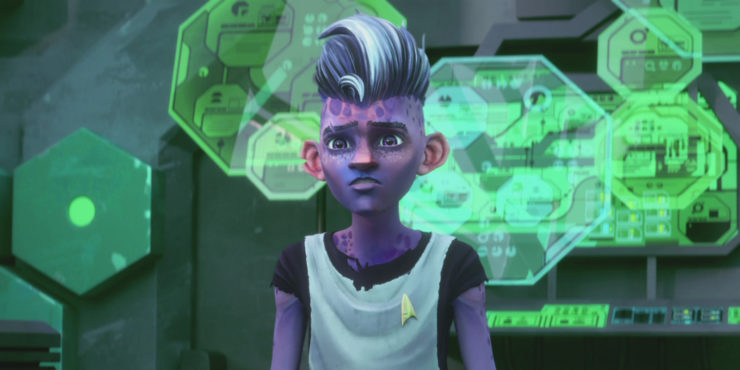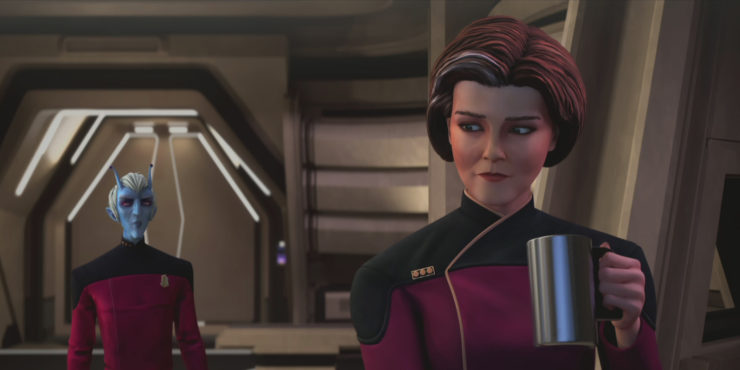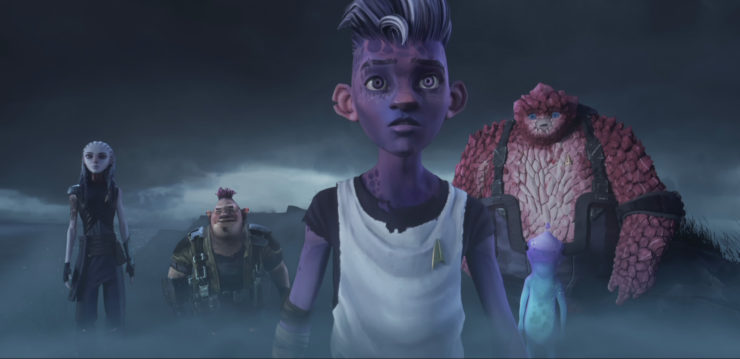In the final seven episodes of Star Trek: Prodigy’s first season, our heroes—emboldened by seeing how Starfleet ideals have improved the lives of the Enderprizians in “All the World’s a Stage”—decided to contact Starfleet one way or another, dagnabbit! Their journey to do so starts at the Denaxi Depot on an ice planet in “Crossroads,” which starts them on an odyssey that leads to a rather nasty set of confrontations in the two-part “Supernova” season finale.
SPOILERS FOR THE ENTIRE FIRST SEASON OF STAR TREK: PRODIGY!
That journey is not quite as smooth as one might like—either in-story for the Protostar crew, or plot-wise for the viewers. One of the things I’ve really liked about Prodigy is that I’ve rarely had to say, “Ah, well, it’s a kids’ show, we should make allowances,” because it hasn’t really had to make those allowances.
These final seven episodes have broken that streak, starting with “Crossroads,” which is a comedy of errors that isn’t really that much of a comedy and winds up being the show’s first big error. Dal and the gang have buried Protostar beneath some snow, since it has a weapon that will destroy Starfleet. But also on that planet at the Denaxi Depot (where the kids are trying to find a ship to hire) are Barniss Frex, who wound up there in his escape pod after the outpost went boom in “Asylum,” and the Dauntless, which is looking for Frex.
Our heroes almost get to make contact with Admiral Janeway and the Dauntless crew, but cheap circumstances contrive to keep them from actually telling the Starfleet personnel the truth. It starts with Pog bumping into Doctor Noum, a fellow Tellarite, but Pog is distracted by Noum dismissively calling him a runt (the name “Pog” generally refers to those “short in size and vocabulary”). Then Dal is about to talk to Janeway when the admiral is interrupted by news from Frex. And Gwyn meets Ensign Acensia, but the latter tells her that another of her species is on board; Gwyn is devastated by the news that her father is still alive and on Dauntless. Then, when they dig up Protostar to run away, Murf (who came out of his chrysalis now having limbs) sits on the weapons console and accidentally fires weapons on Dauntless.
All of this combines to keep our heroes from actually talking to Starfleet, with Starfleet viewing them as terrorists, and it’s patently ridiculous. Just one simple conversation would have done the trick, and the fact that it was avoided was purely one stupid writer trick after another to keep the plot mechanics moving.
Almost as bad is “Ghost in the Machine,” which is Yet Another Holodeck Episode, the very thing that this show was not crying out for. Worse, it’s Yet Another Holodeck Malfunction Episode, a type of story that wore out its welcome pretty much from the first time that trope was used in 1988. It has even less appeal here than on the other Trek productions. On the live-action shows, which are limited by budget and location availability, doing a holodeck story enables you to change up the locales and the costumes and such to provide something visually different. But Prodigy has such superb animation and lush visuals all the time that the holodeck is less exciting. Plus the actual story in “Ghost in the Machine” doesn’t really track, as the Janeway hologram is compromised by the living construct—the super-weapon that destroyed the outpost in “Asylum” and is keeping them from even making subspace contact with Starfleet—to keep them busy in the holodeck, even going so far as to disengage the safeties. Besides my usual complaint as to why safeties aren’t hardwired on all holodecks, there’s the fact that this nasty subroutine should just kill the kids, but it doesn’t, because they have plot armor and it’s a kids’ show. Sigh. It also doesn’t help that all the mysteries and clues and such are just not that interesting. Finding out that Zero is a nerd for a good mystery is entertaining and in character, but it’s not enough to hang a whole episode on.

However, other episodes beyond those two clunkers do provide us with a series of revelations that bring a lot of what’s gone before into focus. We start with “Masquerade,” which finally answers the question of who and what Dal is: a genetically engineered mutt. He’s a mix of dozens of different species, and the reason why he doesn’t remember his parents is because he doesn’t have any—he was grown in a lab. Dal is given an implant that allows him the opportunity to access more directly the various abilities of the species he has floating around in his DNA, which proves useful when the kids wind up in a chase with some nasty Romulans, but he abandons the implant by the end of the episode.
Dal isn’t the only one to have that implant, though: Acensia has one, too, and she’s truly another Vau N’Akat like the Diviner and Gwyn. She goes by the Vindicator, and she even has her very own Drednok…
The very next episode provides more revelations, for both the good guys and the bad guys. With the Diviner still amnesiac, the Vindicator has to provide the full Vau N’Akat story, which we only got the first half of in “A Moral Star.” (Amusingly, Jameela Jamil reverts to her natural British accent as the Vindicator, after faking an American accent for Acensia.) The Protostar traveled forward in time through a wormhole and wound up at the Vau N’Akat homeworld, where the crew was either killed or taken prisoner. They put the living construct on the Protostar, but before they could use it, Captain Chakotay and his first officer were able to send their ship very far back in time so the Vau N’Akat couldn’t use it. After that, the Order was created, of which both the Diviner and the Vindicator are two of the hundred who were sent back in time to find the Protostar and finally use it to destroy Starfleet. The temporal confusion of the early episodes, particularly regarding how long the Protostar was buried on Tars Lamora, is finally explained!
Meanwhile, the kids take a break during repairs of the Protostar to tell each other their origin stories. Rok was an arena fighter who was the evil monster who always lost to the noble hero; when she had the temerity to win a fight once and actually get cheered by the crowd, her partner betrayed her and sold her to a Kazon slaver, who sold her to the Diviner. (This explains why she doesn’t like to fight.) Pog was on a Tellarite sleeper ship, got woken up from stasis by mistake, and wound up being stuck fixing everything that was wrong before being forced to abandon ship to save everyone else. (This flashback also provides an amusing reason why Pog always refers to himself in the third person.) Zero was part of a group of Medusans who were exploring the galaxy, but was caught by some Kazon slavers who lay in ambush for them, though Zero was the only one they actually caught. Points to the scripts for providing good backgrounds for all three, and especially to Rylee Alazraqui, Angus Imrie, and even Jason Mantzoukas who provide useful illumination of Rok, Zero, and Pog, respectively. (Mantzoukas is not a favorite of mine—his recurring role of Adrian Pimento is one of my two least favorite aspects of Brooklyn Nine-Nine, a show I adore otherwise.)
The kids make a last-ditch attempt to contact Starfleet without using technology, and that leads to another old standby, though one that’s not as unwelcome as the holodeck one: the body-swap episode! I’m more forgiving of this overused trope because it’s always fun to observe as an acting exercise. With Zero’s help, Dal and Janeway switch bodies, and both Brett Gray and especially Kate Mulgrew absolutely nail it. Gray channels Janeway’s calm compassion, while Mulgrew hilariously embodies Dal’s seat-of-the-pants approach to, well, everything, not always to a good end. There’s simply no way an ex-slave kid who’s lived the crazy-ass life Dal has is going to be able to properly impersonate a vice admiral, and the Dauntless crew wastes no time in putting Janeway in the brig under medical supervision.
This is a problem insofar as Janeway now knows the whole truth from her time in Dal’s skin. The problem is that the admiral has been declared medically unfit for duty, not aided by “Acensia” working against her secretly.

The two-part finale brings everything together, as the Protostar is now facing a fleet of Starfleet vessels, and the Vindicator is able to get the living construct to activate, causing all the ships to fire on each other and lock out the crews from all systems. It also deactivates the universal translators, so they can’t even all talk to each other.
Here, Gwyn gets to save the day, as she speaks multiple languages, and she puts out a call to the Federation’s allies and civilians to come in and help by using their shields to block the weapons fire that is destroying all the unshielded ships. The problem is, more Starfleet ships are also showing up, and they’re immediately compromised by the living construct.
The carnage here is tremendous, and while the show avoids actually showing people dying, there’s absolutely no way this didn’t result in hundreds, if not thousands, of casualties. By the same token, when the Vindicator, the Diviner, and Drednok board Protostar, for some reason our heroes aren’t killed. Drednok neutralizes everyone but Gwyn, who gets into a swordfight with the Vindicator after the latter locks the Diviner in the belowdeck chamber housing the living construct. The Diviner winds up sacrificing his own life to save Gwyn, and the Vindicator and Drednok escape to presumably continue to be antagonists in season two. John Noble, who was criminally (ahem) underused as the bad guy in the back half of the season, will be seriously missed (though I can think of several ways for the character of the Diviner to appear in season two without reversing his sacrifice here), and I’m glad we still have Drednok, as Jimmi Simpson’s quiet menace is very effective.
The gang is able to figure out, in true Trek style, a technobabble solution to the problem: destroy the ship. The problem is the protodrive exploding will cause the equivalent of a supernova, which will wipe out the fleet (and all the allies who’ve shown up to help). But they figure out a way to engage the protodrive while overloading the regular warp drive, spreading the carnage out over several light-years, muting the damage.
Unfortunately, hologram Janeway has to sacrifice herself to make this happen (she’s had so many experiences with the kids that her program has gotten too large to fit on an isolinear chip, so they can’t copy her over as hoped).
These episodes have some fun tie-ins to the greater Trek universe, and also a potential explanation for one of the crappier aspects of one of the other current shows. When they’re in the Romulan Neutral Zone, there is mention of negotiations, and the timing of this is that it must be negotiations regarding the evacuation of Romulus in anticipation of the supernova (established in the 2009 Star Trek) that Picard was the spearhead of (established in Picard’s first season). Picard later resigned when Starfleet withdrew the support for Romulus after the synth attack on Mars, but now we have something else to go with the Mars attack: the fleet has been devastated by what happens in the “Supernova” two-parter, and that, combined with the attack on Mars, makes Starfleet withdrawal of the support for Romulus make a bit more sense.
That’s my headcanon, anyhow. Beyond that, we’ve also got a couple of appearances by old friends: Ronny Cox returns to voice now-Admiral Jellico (from The Next Generation’s “Chain of Command” two-parter; he was also seen as an admiral in a lot of tie-in fiction over the years) in a couple of episodes, and Billy Campbell does likewise with a now-silver-haired-and-eyepatched Thadium Okona (from TNG’s “The Outrageous Okona”). There are fun touches all over these episodes, from Denaxi Depot being run by Xindi (the first time anyone from that multispecies race has been seen outside of Enterprise), to the Kazon slavers using the same visors Spock used in the original series’ “Is There In Truth No Beauty?” to keep from being driven nuts by seeing Medusans, to Dal’s creation being the continuation of genetic engineering work done way back in the twenty-second century by Arik Soong, as seen in Enterprise’s fourth season.
Buy the Book


Wild Massive
My favorite, though, is a bit that probably will go over the heads of most of the kids watching this, but it warmed my heart anyhow. An ensign guarding the brig on Dauntless turns out to be one of the Brenari refugees that Voyager rescued from the Devore in “Counterpoint.” I just love the notion that the Brenari made it to Federation space and that at least one of the kids joined Starfleet (this season of Prodigy is nine years after “Counterpoint,” so the timing works).
For the first time since this season began, I’ve been less than impressed with the writing, as there are far too many stupid writer tricks to drag the plot out, but the final two-parter (written by creators/show-runners Kevin & Dan Hageman) works very well, with plenty of pathos—the loss of both the Diviner and the Janeway hologram—heroism, and idealism. And in the end, all but Gwyn are accepted into Starfleet—not as Academy cadets, as there’s a process for that, but as warrant officers who will study under Janeway and perhaps be able to enter the Academy down the line. Even Dal is allowed in, even though he’s an Augment. (A stupid rule, that, so I’m happy to see it bypassed. See also the likely plotline for Number One in season two of Strange New Worlds.)
Gwyn is going off to the Vau N’Akat homeworld to try to head off the civil war that causes all this at the pass. Most interesting of all, the destruction of the Protostar has opened another Wormhole To The Future! (the name of my next band), where Chakotay is still in trouble with the Vau N’Akat.
We don’t know exactly what our heroes will be doing in season two—the finale ends before we find that out, though going after Chakotay is one possibility—but they’ll be serving under Janeway in some capacity, which is good, as the true star of this series has been Kate Mulgrew. She’s, in essence, played four different roles: hologram Janeway, evil hologram Janeway as reprogrammed by the Diviner and the living construct, Admiral Janeway, and Dal in Janeway’s body. And she’s played all four superbly. I particularly like how she’s differentiated the Janeway hologram—who’s pretty much the captain of Voyager we watched for seven years two-and-a-half decades ago—from Admiral Janeway—who is very obviously older and crankier but also wiser.
Fourteen months ago I called Prodigy the best of the new Trek series, and while SNW is challenging that position, and while these final seven episodes didn’t all cohere as well as the previous thirteen, I still stand by it, and I say that as someone who likes a lot of what Secret Hideout has been doing since 2017. What I especially love is how well the crew has come together as a team and as a family, and how each character has grown. The best thing about every Trek series has been the characters, and Prodigy continues that, from the diamond-in-the-rough that is Dal to the tragic Gwyn to the earnest Zero to the eager-to-learn Rok to the dirty-hands-zany Pog to the adorable Murf.
Looking forward to season two…
Keith R.A. DeCandido wishes everyone a very happy new year!










